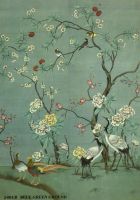Silk screening is a printing technique that uses a silk fabric to support a stenciled ink block and then the image is transferred to a fabric. The process starts when the stenciled ink block is transferred to the mesh. Then a squeegee or a large roller is applied to the stencil which pumps the ink past the threads of the mesh. The silk screen process can be seen on many items and is a popular technique for making T-shirts.
Silk screen printing first appeared during the Song Dynasty in China, which was during the time of 960-1279 CE. The technique would not make its way from Asia to Western Europe until the later years of the 1700s. This was the first time Western Europe learned about this type of stenciling, but it did not gain popularity until much later because its mesh was sparse.
Once the product started surfacing through numerous trades, it became quite popular. This silk screen technique also became popular in Japan. The Japanese used this method along with block printing to make beautiful tapestries and garments, such as printed silk scarves.
While fabrics and clothing have been undergoing the silk screen process for quite some time, it was first patented in 1907, as a way to create wallpaper. Silk screening was used to apply colorful images to fine fabrics, such as linen and even the material silk. This intricate process to make wallpaper became popular quickly.
silk wallpaper
silk wallpaper
silk wallpaper
silk wallpaper
silk wallpaper
silk wallpaper
The process not only drew attention to those who wanted to purchase the wallpaper, but also from those who wanted to make their own profit. This did not happen for quite some time, simply because the process was kept a secret and it took a while before it was revealed. Though the technique is still used today to make wallpaper, many other items such like CDs, T-shirts and ceramics are sold on the market.
When we think of silk screening, t-shirts are the main item that comes to mind. However, the process can be used to add bold sharp images to almost any product out there. Years ago, a printed ceramic vase would have been hand painted. Today, the process makes it possible for these vases to be mass produced and to execute beautiful graphics that were once not thought possible.






No comments:
Post a Comment